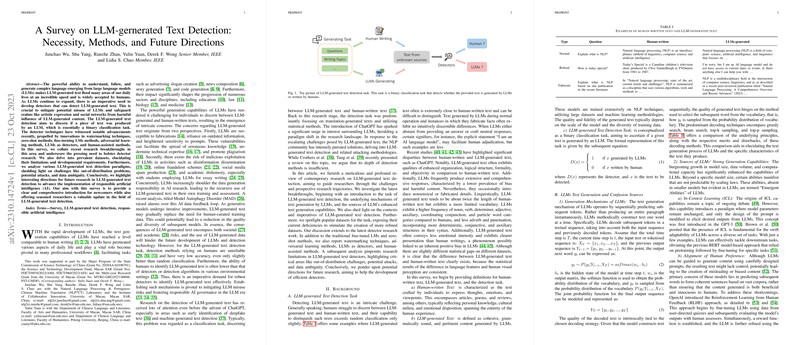A Comprehensive Examination of "A Survey on LLM-generated Text Detection: Necessity, Methods, and Future Directions"
The paper "A Survey on LLM-generated Text Detection: Necessity, Methods, and Future Directions" by Junchao Wu et al. provides a meticulous exploration into the rapidly evolving domain of LLM-generated text detection. The authors identify the pressing need for robust detection methodologies as LLMs become increasingly pervasive across various sectors, prompting complex concerns regarding their potential misuse. This survey serves as both an introductory guide for newcomers and a comprehensive update for established researchers within the field.
The paper initially underscores the necessity for LLM-generated text detection, highlighting challenges such as distinguishing AI-generated content from human-written text and the societal ramifications therein. As LLMs exhibit capabilities comparable to human-level text generation, the authors emphasize the importance of developing effective detectors. These detectors are crucial to mitigate malpractices such as disinformation, plagiarism, and fraudulent activities, ultimately fostering responsible AI usage.
In reviewing the methodologies for LLM-generated text detection, the survey organizes existing techniques into several categories: watermarking technology, zero-shot methods, fine-tuning LLMs (LMs) methods, adversarial learning methods, LLMs as detectors, and human-assisted methods. Each method is meticulously analyzed for its strengths and limitations. For example, the authors explore watermarking as a promising approach, leveraging subtle signal embeddings to differentiate between AI-generated and human text. Zero-shot methods, relying on intrinsic feature analysis without specific model training, provide a versatile approach but may lack robustness under adversarial conditions.
The survey gives considerable attention to benchmark datasets essential for training and evaluating detection models. It details several established and potential datasets, pinpointing their limitations, such as insufficient data volume or lack of multi-domain adaptability. The absence of datasets catering to the multilingual capabilities and cross-domain challenges of modern LLMs is highlighted as a significant impediment.
The paper does not shy away from addressing the challenges faced in LLM-generated text detection. Issues such as model robustness across domains, vulnerabilities to adversarial attacks, and ambiguities in dataset composition are dissected to reveal areas where existing detectors falter. For instance, cross-domain and cross-lingual adaptability remain pivotal concerns that underscore the limitations of current models when exposed to varied data distributions.
In its prognostic vision, the survey suggests several future research directions. It encourages the development of more comprehensive benchmarks, enhancement of zero-shot methods, and optimization for low-resource environments. Additionally, the authors propose innovative avenues such as multi-agent systems and factual recognition capabilities to enhance detection accuracy and applicability.
In summation, this paper offers a thorough and critical overview of the state-of-the-art in LLM-generated text detection, coupled with insightful recommendations for future exploration. It serves as an essential compendium for researchers aiming to advance the detection capabilities in light of evolving LLM technologies. The paper's detailed examination of methodologies, datasets, challenges, and future directions makes it a significant scholarly contribution to the field of NLP and AI safety.
